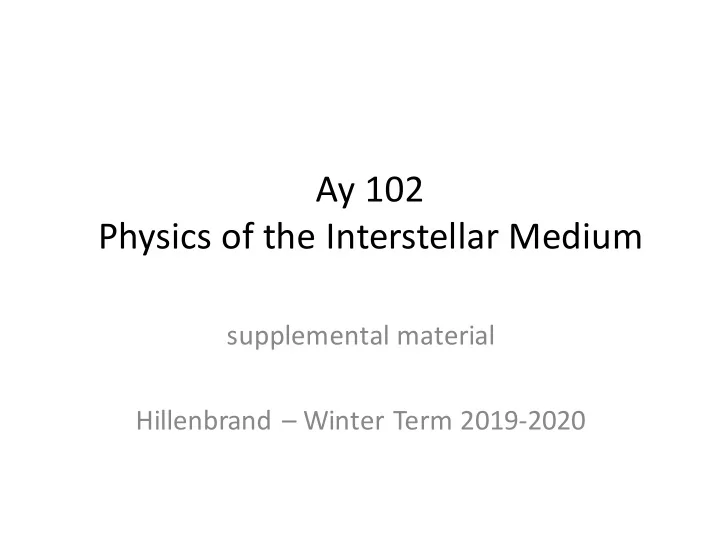

Ay 102 Physics of the Interstellar Medium supplemental material Hillenbrand – Winter Term 2019-2020
The Hot Ionized Medium è Xrays and UV
Orion – The Example of Everything Interesting!
NGC 604 in M33 IRAC = dust GALEX = hot stars Xray = hot gas Lines = warm gas; note that bubbles visible in Hα (red) are filled with hot gas (blue) Tullmann et al (2008)
Crab Nebula – Supernova Remnant optical near-infrared xray radio
All-Sky in X-rays (point sources removed)
solar core Very High-T, this room Very Low-n plasma HIM Diffuse Galactic ISM and the IGM
Physical Processes in the HIM • Because of high temperature – have rapidly moving e - – Collisional ionization needs to be considered in addition to the excitation (described by C lu ) we have discussed already. – No molecules to worry about, or neutral atoms. – Mostly far-ultraviolet and x-ray emission lines. • Because of low density – Density is always lower than the critical density. – Rates (n e 2 ) << Rates (n e ) << Rates (spontaneous de-excit.) – As for the WIM, in the HIM, radiative decay dominates collisions. So have collisions mostly from the ground level of ions. This is called K-shell ionization, with n=2 called L-shell. – Recombination line ratios are independent of density è T e .
Diagnostics of the HIM • X-rays = thermal bremsstrahlung (free-free) – T > 10 7 K - continuous spectrum with E -0.4 e -E/kT • X-ray, UV, Optical lines = high-ionization species – 10 4.5 < T < 10 6.3 K - metals K- and L-shell ionization – 10 6.3 < T < 10 7 K - Fe L-shell collisional ionization
Collisional Ionization Concept • Not enough UV to produce such high temperatures by photo-ionization. • Instead, fast-moving electrons in stellar winds and in supernova shocks è collisional ionization. • Steady-state ionization balance w/recombination (as before in WIM, yet different here in HIM). • “Collisional Ionization Equilibrium” = C.I.E.
(sorry about the comic sans…) Collisional Ionization Description
Collisional Ionization Cross Section Example Inner shells require higher energy e- and have smaller cross section Dopita & Sutherland
A. Glassgold
Result from the rate equations for collisional ionization in the non-LTE ISM is Saha-like curves for the different ionization states (similar in nature to those resulting from LTE photo-ionization in stars).
Temperature Determines Ionization State Oxygen from Neutral to Highly Ionized
Temperature Determines Ionization State Iron from Neutral to Highly Ionized
(WIM) Opacity at High Energies τ ν = ∫ α ν d ν (HIM) (1keV) (13.6eV) Dopita & Sutherland
UV photons are readily absorbed, X-ray Opacity but galaxy becomes optically thin again at E > 0.2 keV. Cross sections including H, He, metals Same as above, but cast in terms of distance. τ ν = ∫ σ ν n dl analog expressed in energy units
Diagnostic Lines from Ionization ++ Recombination
The top panel shows helium-like and hydrogen-like charge states of various X-ray Lines low-Z atoms. The bottom panel shows iron ions having the outer electron in the K, L, and M shell. The bottom panel indicates how the measurement of various ions in the iron series is a sensitive probe of whether plasma at a given temperature exists. Figure uses data from Arnaud & Raymond (1992). (elemental abundance times fraction ionic abundance) Peterson & Fabian (1996)
X-ray Spectrum
These hot lines IR opt UV x-ray IR opt UV x-ray sit on top of a continuum spectrum which comes from “free-free” emission
Free-Free Continuum a.k.a. Bremsstrahlung Radiation E -0.4 e -E/kT Range of relative KE between the free e - and the heavy ion + è ”continuum” process https://www.nde-ed.org/EducationResources/CommunityCollege/Radiography/Physics/xrays.htm
Same process occurs at low energies (radio) for p and e in the WIM J. Williams
The Emission Measure D. Dallacasa
CGM / IGM • CGM refers to the gas and dark matter outside of galaxies, but still within the radius of the collapsed, virialized cosmological dark matter structure around the galaxies. This is the interface zone between galactic inflows and outflows. • IGM refers to the even lower density gas, located outside of these radii, which also displays structure. • Most of the baryons appear to be in the CGM! So far, the extremely diffuse, hot ionized gas is our only probe.
T. Greve
Tumlinson et al 2017; ARAA
Spectrum of background QSO absorbed by CGM of foreground QSO Background QSO spectrum Flux Foreground QSO spectrum 𝑆 " Flux slide courtesy P. Parihar
UV Absorption Lines CGM gas at 3x10 5 - 10 7 K ! Tumlinson et al 2017; ARAA
X-ray Halos in Galaxy Clusters IGM gas at 10 7 -10 8 K ! Abell 2029
Recommend
More recommend